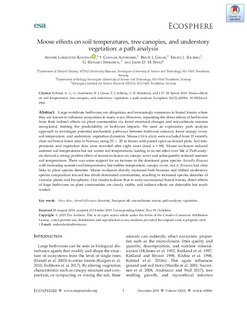| dc.contributor.author | Kolstad, Anders Lorentzen | |
| dc.contributor.author | Austrheim, Gunnar | |
| dc.contributor.author | Graae, Bente Jessen | |
| dc.contributor.author | Solberg, Erling Johan | |
| dc.contributor.author | Strimbeck, Richard | |
| dc.contributor.author | Speed, James David Mervyn | |
| dc.date.accessioned | 2020-01-21T10:24:11Z | |
| dc.date.available | 2020-01-21T10:24:11Z | |
| dc.date.created | 2019-12-17T09:41:34Z | |
| dc.date.issued | 2018 | |
| dc.identifier.issn | 2150-8925 | |
| dc.identifier.uri | http://hdl.handle.net/11250/2637194 | |
| dc.description.abstract | Large vertebrate herbivores are ubiquitous and increasingly numerous in boreal forests where they are known to influence ecosystems in many ways. However, separating the direct effects of herbivores from their indirect effects on plant communities via forest structural changes and microclimate remains unexplored, limiting the predictability of herbivore impacts. We used an exploratory path analysis approach to investigate potential mechanistic pathways between herbivore removal, forest canopy cover, soil temperature, and understory vegetation dynamics. Moose (Alces alces) were excluded from 15 recently clear‐cut boreal forest sites in Norway using 20 × 20 m fences with paired open un‐fenced plots. Soil temperatures and vegetation data were recorded after eight years (total n = 98). Moose exclusion reduced summer soil temperatures but not winter soil temperatures, leading to no net effect over 344 d. Path analysis showed a strong positive effect of moose exclusion on canopy cover and subsequently reduced summer soil temperatures. There was some support for an increase in the dominant grass species Avenella flexuosa with increasing summer soil temperatures, but neither temperature, canopy cover, nor A. flexuosa had clear links to plant species densities. Moose exclusion directly increased herb biomass and shifted understory species composition toward less shrub‐dominated communities, resulting in increased species densities of vascular plants and bryophytes. Our results indicate that in early‐successional boreal forests, direct effects of large herbivores on plant communities are clearly visible, and indirect effects are detectable but much weaker. | nb_NO |
| dc.language.iso | eng | nb_NO |
| dc.publisher | Ecological Society of America | nb_NO |
| dc.rights | Navngivelse 4.0 Internasjonal | * |
| dc.rights.uri | http://creativecommons.org/licenses/by/4.0/deed.no | * |
| dc.title | Moose effects on soil temperatures, tree canopies, and understory vegetation: a path analysis | nb_NO |
| dc.type | Journal article | nb_NO |
| dc.type | Peer reviewed | nb_NO |
| dc.description.version | publishedVersion | nb_NO |
| dc.source.volume | 10 | nb_NO |
| dc.source.journal | Ecosphere | nb_NO |
| dc.source.issue | 12 | nb_NO |
| dc.identifier.doi | 10.1002/ecs2.2966 | |
| dc.identifier.cristin | 1761631 | |
| dc.description.localcode | © 2019 The Authors. This is an open access article under the terms of the Creative Commons Attribution License, which permits use, distribution and reproduction in any medium, provided the original work is properly cited. | nb_NO |
| cristin.unitcode | 194,31,10,0 | |
| cristin.unitcode | 194,66,10,0 | |
| cristin.unitname | Institutt for naturhistorie | |
| cristin.unitname | Institutt for biologi | |
| cristin.ispublished | true | |
| cristin.fulltext | original | |
| cristin.qualitycode | 1 | |

